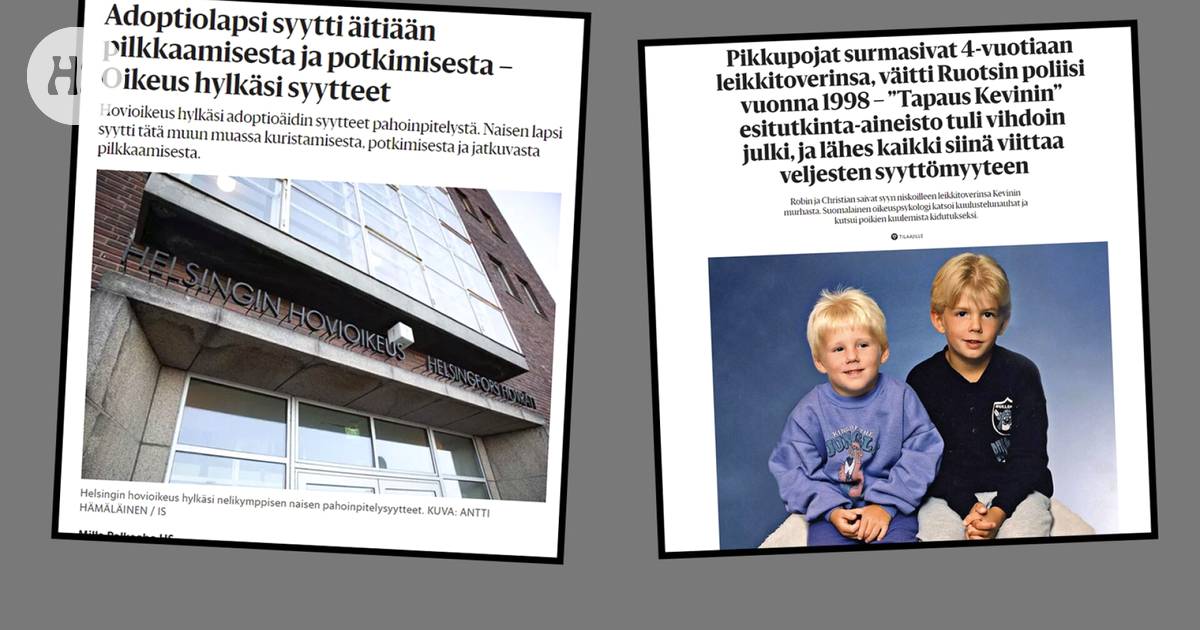Children’s untruthful accounts of violence rarely involve deliberate lying. Often false narratives are driven by misinformation or social pressure, says Docent of Forensic Psychiatry Taina Laajasalo.
Helsingin sanomat newspaper reported on Friday Anneli Auerin about the case where her children have told that they lied about being victims of crimes during the preliminary investigation and legal process years ago.
Auer and her ex-boyfriend were sentenced to long prison terms in 2013. The verdict was largely based on Auer’s three children’s accounts of abuse and other acts against them.
Now the children say that no crimes took place, and Auer and the man are asking the Supreme Court to overturn the sentences.
Read more: Anneli Auer’s children withdraw their testimony against their mother – video seen by HS: “It really didn’t happen”
Junior convictions have been handed down on the basis of false reports before.
One of the most famous examples of false testimony given by children is the Swedish “Kevin Case”. In August 1998, a four-year-old was found dead on the shore of the lake Kevin Hjalmarsson.
A couple of months later, the police told a press conference that the 5-year-old Robin and his 7-year-old older brother Christian had confessed to the act during interrogations. They were Kevin’s playmates.
Because the children were so young, there was never a trial and they were never convicted. Instead, the Swedish social authorities took the boys into their homes.
After almost two decades, the investigation was reopened. In March 2018, the prosecutor released brothers from doubts. According to the prosecutor, based on the information revealed in the investigation, it could not be concluded that the boys were even present when the murder was committed.
Read more: The preliminary investigation file of the “Kevin case” has finally been released, and almost everything in it points to the brothers’ innocence
Cases of violencein which sentences are handed down on the basis of a child’s false story, are not very common but not unusual either, says docent of forensic psychology, leading researcher of the Institute of Health and Welfare (THL) Taina Laajasalo.
Read more: Expert: This is how adults may lead children even without knowing it
Laajasalo says forensic psychologist by Julia Korkman having consulted him for his own statement Anneli Auerin regarding the case. Since Laajasalo has not otherwise been involved in the case, he does not comment on Auer’s case, but speaks on a general level.
Many times the cases do not even end up on the prosecutor’s desk. Often, the true side of things is revealed already in the investigation phase, either on the basis of other investigations or by the fact that the child himself has actively told that what he said is not true.
Taina Laajasalo is involved in THL’s Barnahus project, which enhances the investigation processes of suspected violence against children and the support and treatment of children who have experienced violence.
Still examples of wrong judgments can also be found in Finland.
In February, the Helsinki Court of Appeal rejected the adoptive mother’s charges of abuse. He had been sentenced to two counts of assault and fined in the district court after a woman accused by a child of physical and mental abuse.
According to the Court of Appeal, the preliminary investigation material was partly incomplete, because the reliability of the child’s story was not assessed with the help of experts, taking into account the child’s background and level of development.
The child had also been in contact with witnesses before the Court of Appeal proceedings. He had said that he had exaggerated or lied about the violence he had experienced in order to get attention.
In 2019, the Supreme Court again overturned a conviction for the sexual abuse of a child due to factors related to the way the memory images of the person concerned were created, which undermined the reliability of the report.
Read more: An adopted child accused his mother of mocking and kicking him – the court rejected the charges
“
“The younger the child, the less often it is a matter of fully conscious lying.”
Often it is thought that if a child tells a false story, it would be lying. It is much more common that it is a question of distortion of memories and the child himself believes what he has been told, says Laajasalo.
“The typical scenario is that there is a very strongly worried adult, who can unintentionally drive by leading the child to tell things that are not true.”
The child may also be driven to tell untrue things due to social pressure. For example, in difficult custody dispute situations, the child may tell untrue things because he adapts to the other guardian’s perception of the other party to the dispute.
“The younger the child, the less often it is a matter of fully conscious lying. Often it’s about leading the child on, social pressure or a conflict of loyalty,” says Laajasalo.
When children are heard in criminal cases, the interviews must be done carefully. You must avoid introductions and use an evidence-based interview framework. During the interview, the child should not be informed of things that he has not brought up himself.
The introduction can be, for example, statements interpreting the child’s experience. For example, it is stated that “it must have hurt really hard” before the child has said anything referring to pain. Or we ask, “did he touch you under the shirt”, even if the child has not said that he has been touched.
The introduction can also be non-verbal.
“For example, you can strongly communicate to the child what kind of answer is expected from him. Or, for example, we repeat a certain question for so long that the child answers it in the expected way,” says Laajasalo.
“
“It is not enough to evaluate only what the child has said, but the overall context of the story should be understood.”
Laajasalon according to the police who conduct interviews in Finland, compared internationally, they are highly trained for interviewing children. In the most challenging cases and for the most vulnerable children, the interviews are conducted by a forensic psychologist.
An even separate task is the assessment of the reliability of the child’s story. When assessing reliability, not only how the child was interviewed, but also the history of the child’s story is examined. The authorities can request reliability assessments from the forensic psychiatric unit for children and young people.
In the reliability assessment, we look at what kind of situation the child’s story came out in and with whom. If, for example, a suspicion of violence has come up, has it come up spontaneously as told by the child? When did the suspicion arise, what kind of discussions were held about it and over how long?
“It is not enough to evaluate only what the child has said, but the overall context of the story should be understood,” says Laajasalo.
In addition, it can be examined whether the child has a tendency to lie.
“All children and adults sometimes cheat. It is significant in the evaluation if the child has been diagnosed with, for example, a behavioral disorder that involves lying. Even this does not automatically mean that the story is unreliable, and this too is always evaluated in relation to the whole.”
System is not without gaps, Laajasalo points out. When it comes to children’s hearings, mistakes happen in both directions. Although there have been false convictions based on children’s stories, it is more common for the real violence to remain hidden.
“Both are tragic situations for the child.”
#case #Anneli #Auer #sentences #handed #based #childrens #false #stories #expert #explains #child #starts #telling #fairy #tales



/s3/static.nrc.nl/images/gn4/stripped/data114968659-fc3572.jpg)




